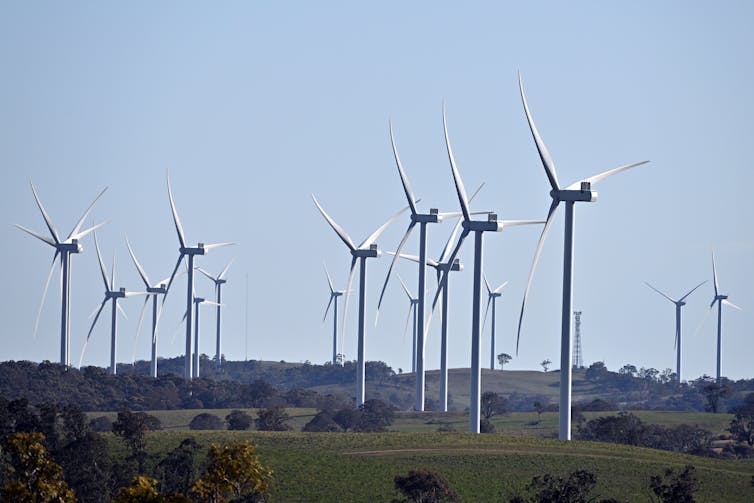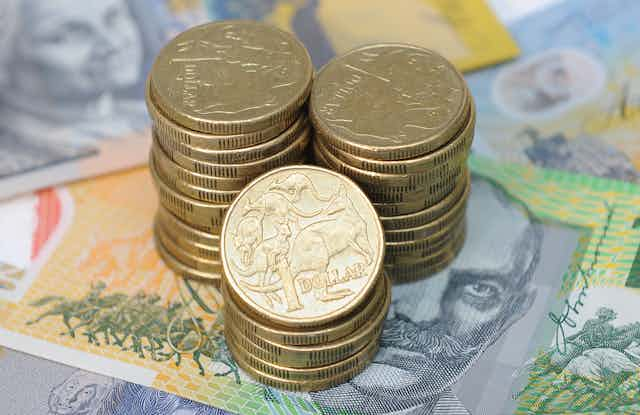Few of us pay much attention to our superannuation. Under the Superannuation Guarantee, employers pay at least 11% of salaries into their employees’ super funds without workers having to do anything.
These accumulating automatic payments have turned the Australian super fund industry into one of the world’s largest, and the fastest-growing. Worth $A3.5 trillion, our superfunds sit alongside funds from Canada, Japan, Netherlands, Switzerland, the United Kingdom and United States to make up 92% of total global pension assets.
But none of these funds are investing enough in the net zero transition. Institutional investors, of which super funds are a vital part, provided less than 1% of all direct private climate change finance globally in 2021/2022- a contribution of around $US6 billion. This is far from the trillions needed every year to finance renewable energy projects, cleaner industrial processes, and replacing fossil fuels in transport, among other initiatives.
At the same time, many Australian funds continue to invest in carbon-producing companies, such as oil and gas, even when they claim to be making “green” investments.
This article outlines reforms the federal government could undertake to encourage super funds to tackle the climate crisis. This would help align the super system with its original purpose: to provide a better standard of living for the millions of us who will retire on a climate-damaged planet.
The Albanese government’s sustainable finance plan
Treasurer Jim Chalmers is aware of the unmet potential of super funds. Treasury’s Sustainable Finance Strategy, released in November, outlines measures underway or in development to enable more sustainable investment. The Australian Sustainable Finance Taxonomy, for example, helps investors and regulators to identify whether an investment is “green”.
Read more: Making money green: Australia takes its first steps towards a net zero finance strategy
Last month Chalmers held an “Investor Roundtable” that brought together heads of superannuation funds and others to discuss how to scale up investment in climate change.

Funds expressed their intent to make more investments aligned with net zero. Studies consistently show most large Australian funds have pledged to support net zero and established investment targets. Yet they say several regulatory roadblocks hinder them from turning their commitments into action.
The government has said it will make reforms on one roadblock – the funds’ performance-testing framework.
Why super funds rarely invest in clean energy
Because superannuation funds are required by law to invest retirement savings for the best return for their members, they give preference to investments that offer the best financial returns with the lowest level of risk.
Funds see companies that are developing and deploying new technologies or operating in areas of significant public policy change as higher risk. That’s a big reason why new green technologies struggle to attract institutional capital compared to those based on fossil fuels.
Super funds consistently note in annual surveys that the lack of green investment opportunities with the right risk-adjusted return profile is a huge barrier to exapanding climate-aligned investment. And recent legislative changes have made the situation worse.
Under the Your Super Your Future scheme, announced in the 2020-21 Budget, the financial regulator for super funds evaluates funds each year by comparing their performance over an eight-year time period against one of 11 “benchmark” investment portfolios.
This process aims to weed out underachieving funds and to protect members from losing money. Funds that are found to underperform must disclose the fact to their members, and persistent failures cannot accept new member funds. This tough sanction has led funds to “hug the benchmark”, meaning they pursue investment strategies to beat the performance test and their peers.
The result, as studies show, is that funds are discouraged from pursuing climate-related investments. The test encourages funds to invest in companies or projects that deliver returns over time frames that are too short for most climate-related investments to achieve returns.
Read more: Australian homes can be made climate-ready, reducing bills and emissions – a new report shows how

Treasury has announced it will extend the performance test period to ten years, and adjust it “to ensure that funds are not unintentionally discouraged from investing in certain assets”. These are encouraging first steps but they are not enough.
Letting ordinary fund members invest in a greener planet
Melbourne Climate Futures’ research has uncovered further regulatory barriers that are stalling investment. One relates to the way individual members choose investments.
Since its establishment by the Keating government in 1992, the Superannuation Guarantee has given individuals some choice over how they handle their superannuation. While many are placed into a fund with a default investment option when they begin work, they are able to choose different investment approaches.
Some of these focus on a theme, such as sustainability, and some offer different levels of risk exposure. Encouraging individuals to direct more of their super to green companies and projects could be a powerful tool to enable more climate investment.
Surveys show more than half of Australians support greater climate action. While many people would not support their super fund making climate investments that hurt their returns, at least some members would. Yet the rigid nature of the best-financial-interest duty, combined with the performance test, prevents funds from offering members the option to put the climate first.
This needs to change. The government could amend the best-financial-interest duty so individuals can instruct their funds to invest their money in projects that reduce long-term and systemic financial risks such as climate change. A tax break or a matching contribution from government could also encourage individuals to choose sustainable investment options.
Climate change poses a grave risk to the health, wellbeing and finances of all Australians, including retirees. Federal policy reform is urgently needed to unlock more superannuation for green investment, harness the power and preferences of individual members and help reduce future climate impacts.
Read more: Too hard basket: why climate change is defeating our political system

